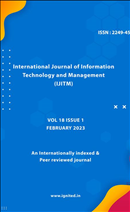Impact of multi-model machine learning approach prediction of Covid-19
Main Article Content
Authors
Abstract
A present study was to analyzed the “Impact of multi-model machine learning approach predication of Covid-19.” Materials and Methods has been used to a cluster sample from secondary source. A data was taken 250 Covid- 19 simple from cross-sectional online survey was conducted for A.N.C.H. Gaya, in the month of August 2020. Both of the simple size the age range of 25 to 65 years and including interns were enrolled in the study. The study was approved by the ministry of India and Arogya Setu application and medical institutional ethics committee. Online informed consent was obtained from each participant and the information was gathered using a google form administered open ended questionnaire (5 items) to the participants. Out of 500 participants from A.N.C.H. Gaya, while 250 participated and filled the questionnaire completely. All the data were collected digitally and analyzed for the results.
Downloads
Article Details
Section
References
- Masum, A. K. M., Khushbu, S. A., Keya, M., Abujar, S., & Hossain, S. A. (2020). COVID-19 in Bangladesh: a deeper outlook into the forecast with prediction of upcoming per day cases using time series. Procedia Computer Science, 178, 291-300.
- Alamo, T., Reina, D. G., Mammarella, M., & Abella, A. (2020). Covid-19: Open-data resources for monitoring, modeling, and forecasting the epidemic. Electronics, 9(5), 827.
- Alimadadi, A., Aryal, S., Manandhar, I., Munroe, P. B., Joe, B., & Cheng, X. (2020). Artificial intelligence and machine learning to fight COVID-19. Physiological genomics, 52(4), 200-202.
- Al-Qaness, M. A., Ewees, A. A., Fan, H., & Abd El Aziz, M. (2020). Optimization method for forecasting confirmed cases of COVID-19 in China. Journal of Clinical Medicine, 9(3), 674.
- Ardabili, S. F., Mosavi, A., Ghamisi, P., Ferdinand, F., Varkonyi-Koczy, A. R., Reuter, U., & Atkinson, P. M. (2020). Covid-19 outbreak prediction with machine learning. Algorithms, 13(10), 249.
- Azarafza, M., Azarafza, M., & Tanha, J. (2020). COVID-19 infection forecasting based on deep learning in Iran, medRxiv.
- Baldé, M. A. (2020). Fitting SIR model to COVID-19 pandemic data and comparative forecasting with machine learning. medRxiv.
- Car, Z., Baressi Šegota, S., Andelić, N., Lorencin, I., & Mrzljak, V. (2020). Modeling the spread of COVID-19 infection using a multilayer perceptron. Computational and mathematical methods in medicine, 2020.
- Dandekar, R., & Barbastathis, G. (2020). Quantifying the effect of quarantine control in Covid19 infectious spread using machine learning, medRxiv.
- Iwendi, C., Bashir, A. K., Peshkar, A., Sujatha, R., Chatterjee, J. M., Pasupuleti, S., ... & Jo, O. (2020). COVID-19 patient health prediction using boosted random forest algorithm. Frontiers in public health, 8, 357.
- Khan, S., Bashir, A. K., Iwendi, C., Gadekallu, T. R., & Deepa, N. (2020). A feature extraction based approach to detect Covid-19 related fake news. Appl Soft Comput.
- Huang, C. J., Chen, Y. H., Ma, Y., & Kuo, P. H. (2020). Multiple-input deep convolutional neural network model for covid-19 forecasting in china. MedRxiv.

